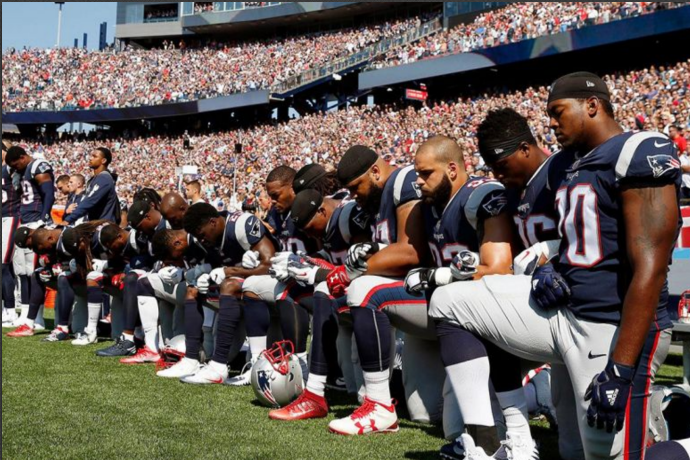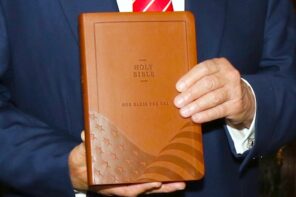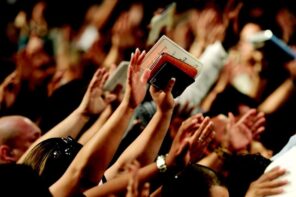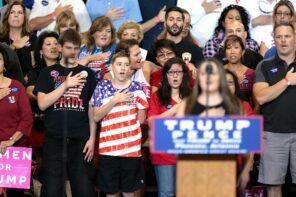Standing before a crowd of mostly white supporters at a campaign rally in Alabama this past week, President Donald Trump again threw himself into the debate on patriotism, protest, athletes and race. Referring to the mostly African American professional football players protesting institutional racism by kneeling during the national anthem, Trump declared, “Wouldn’t you love to see one of these NFL owners, when somebody disrespects our flag, to say, ‘Get that son of a bitch off the field right now. Out! He’s fired!’”
Attendees, media and the public rightly understood Trump to be referencing the protests sparked last year by Colin Kaepernick, who knelt during the national anthem to protest institutional racial oppression. Last year, I wrote about how civil religion helps us understand the nature of Kaepernick’s protests and the responses to it.
Since then, other football players have extended such protests, with a subsequent increase in national attention. As Joseph Winters pointed out here on RD, one cannot separate the vitriolic response to the protests from their racial basis. “Black bodies have routinely been imagined as sources of disorder and danger, especially when they don’t stay in their proper place,” he wrote. What could be more out of place than a protesting knelt black body during the pinnacle of patriotic pride, the national anthem?
But in his speech last week, Trump added something new to his attack on these protesting black athletes. Immediately after criticizing Kaepernick and the protesters, Trump attacked the National Football League itself for becoming too soft, too safe, and putting the health of its athletes above the entertainment value of the violent spectacle. Referring to the NFL’s new rules intended to prevent concussions, Trump said, “They’re ruining the game! They’re ruining the game. That’s what they want to do. They want to hit. They want to hit! It is hurting the game.” He explicitly criticized NFL referees for seeking to curtail such violence.
Here Trump links the salvific violence of the game with patriotism, protest and power. The NFL, Trump railed, has failed to curb protest and promote appropriate patriotism, and instead has targeted violence. He implicitly contrasts a safer, less violent league under the sway of (mostly black) protesting players, with a violent, hard-hitting league under the firm control of (mostly white) patriotic owners.
Thinking about the place of violence in American civil religion helps solve a perplexing theme present in the yearlong debate over professional athletes’ protests.
Coverage of Trump’s speech and the tweets that followed have focused on the growing rift between the African American athletic community and Trump. Justly so. But an equally important aspect of this most recent flare-up of a yearlong conflict is the explicit valuation of athletic violence by the president. Trump linked these two concepts—race and violence—through his rhetoric of ejection, of throwing out the offending player. He objects to referees ejecting players for unnecessary roughness, paraphrasing them, “Today if you hit too hard—15 yards! Throw him out of the game!” By contrast, Trump wants to eject the protesting players from not only the game, but the sport.
The intersections of violence are striking: the real violence of tackling, the symbolic violence of protest, the imagined social violence of disruptive black protest, and the rhetorical violence of ejecting players.
Historian and theologian Jon Pahl argued in Empire of Sacrifice: The Religious Origins of American Violence that American history and society is marked by especially high degrees of both religion and violence. He finds “identifiably religious” patterns in this violence, particularly “systematic exclusions, prejudices, or biases—that is, ritualized incantations or performances—that substitute violence against scapegoats or victims for actual solutions to social problems.” Like my own approach, Pahl envisions American civil religion as an integral part of this process, providing symbols and structures that create an American identity at the expense of sacrificed others, which includes the racially and religiously disempowered.
Violence lies at the heart of American civil religion. Religiously supported violence against Native Americans and enslaved Africans literally built the country, just as religiously sanctioned violence against wartime enemies including fascists and communists sustained it. Capital punishment, a massive prison industry and a militarized police force maintain the social order. For good and for evil, violence is central to our society. We extol it as patriotic, and it is supported by religious institutions through ritual and word.
Football sublimates violence, encapsulates it within the spectacle of sports, but retains the same patriotic emphasis on violence. Violence, or at least the capacity towards violence, is seen as manly, muscular and patriotic. Trump knows this, and he (consciously or not) creates a binary between violent/patriotic/good and safe/protesting/bad. The racial overtones are clear.
Thinking about the place of violence in American civil religion helps solve a perplexing theme present in the debate over professional athletes’ protests. Those opposed to the protests frequently invoke police and the armed forces as reasons to respect the flag and not to protest during the national anthem. “This is about respect for the military, the first responders,” claimed Treasury Secretary Steven Mnuchin, in defense of the president’s position.
Nationalism, violence, race and religion: all are tied up in this discourse. The protests will continue, as will opposition to them. It’s not an anomaly, it’s an integral part of the American story.





